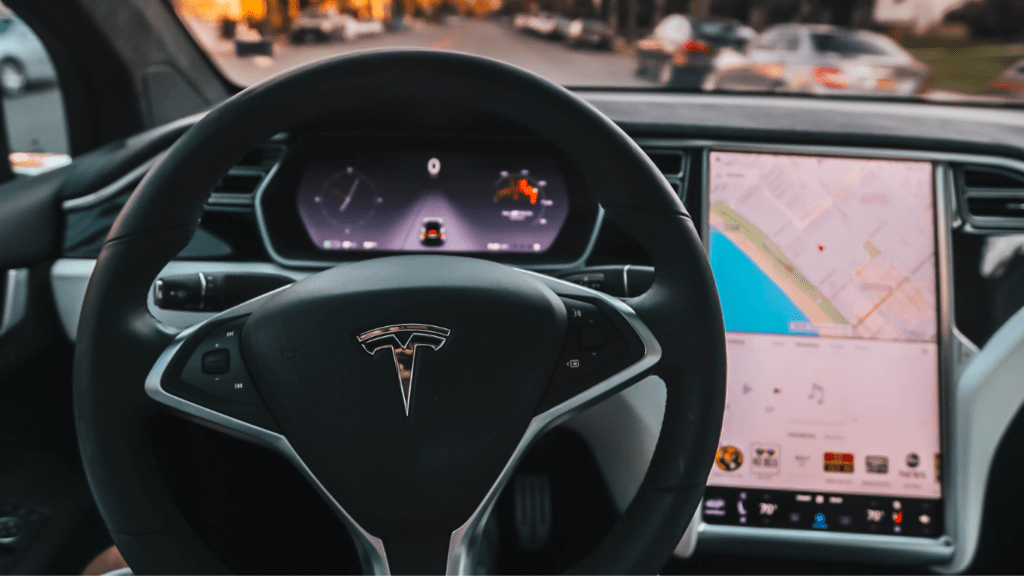Current State of Self-Driving Electric Cars
Self-driving electric cars have advanced significantly in recent years. Major companies are developing autonomous technology and electric powertrains, merging them for a sustainable future.
Major Players in the Market
Several companies lead the self-driving electric car market:
- Tesla: Tesla’s Full Self-Driving (FSD) system remains at the forefront, with their electric vehicles (EVs) featuring significant autonomous functionalities. Tesla’s emphasis on data collection from its fleet enhances the AI algorithms.
- Waymo: Alphabet’s Waymo focuses on autonomous technology through its Waymo Driver. Waymo’s years of testing in diverse urban environments provide a robust foundation for self-driving capabilities.
- General Motors: GM’s Cruise division aims to deploy commercial self-driving electric vehicles. Their all-electric, autonomous Cruise Origin represents a significant step toward shared, autonomous urban mobility.
- Nuro: Nuro specializes in small, autonomous delivery vehicles. Their low-speed electric vehicles serve local delivery needs, steadily gaining regulatory approvals.
- Baidu: Baidu’s Apollo project advances autonomous electric car technology in China. They’ve made strides in deploying robotaxis in controlled environments.
Advancements in Technology
Recent advancements drive the integration of self-driving and electric technologies:
- AI and Machine Learning: Sophisticated AI models process vast datasets from sensors, cameras, and radar systems. These technologies enable real-time decision-making and improve driving accuracy.
- Battery Technology: Enhanced battery capacities and faster charging times make electric vehicles more viable for long-distance travel. Solid-state batteries represent the next leap, offering higher energy densities and safety.
- Sensor Fusion: Combining data from LiDAR, radar, and cameras ensures precise environmental understanding. This fusion enhances the vehicle’s ability to navigate complex urban settings.
- Connectivity: V2X (Vehicle to Everything) communication improves coordination with traffic signals, other vehicles, and infrastructure, reducing congestion and accidents.
- Regulatory Frameworks: Governments worldwide are setting standards and regulations for autonomous vehicles. These frameworks ensure safety and pave the way for broader adoption.
By focusing on these factors, the self-driving electric car industry moves closer to mainstream deployment.
Benefits of Self-Driving Electric Cars

Self-driving electric cars offer numerous benefits that have the potential to transform our society. These advantages span environmental, safety, and convenience aspects, making these vehicles more than just a technological advancement.
Environmental Impact
Self-driving electric cars drastically reduce carbon emissions compared to traditional gasoline vehicles since they run on electricity. According to the U.S. Environmental Protection Agency (EPA), electric vehicles produce zero tailpipe emissions. This reduction in greenhouse gases can mitigate climate change effects and improve air quality, especially in urban areas. Autonomous technology also optimizes driving patterns, further enhancing energy efficiency and promoting sustainable urban development.
Safety Improvements
Self-driving technology significantly lowers the risk of traffic accidents, as human error causes 94% of crashes, according to the National Highway Traffic Safety Administration (NHTSA). Advanced sensors and real-time data processing enable autonomous vehicles to react faster to potential hazards. Features like automatic emergency braking, lane-keeping assistance, and adaptive cruise control enhance safety by mitigating human error. This results in fewer fatalities and injuries on the road, making commuting safer for everyone.
Convenience and Efficiency
Self-driving electric cars bring unparalleled convenience and efficiency to daily commutes. Autonomous vehicles can optimize routes in real-time, reducing travel time and alleviating traffic congestion. Passengers can focus on other activities, like working or relaxing, hence improving productivity. Additionally, these cars can drop passengers off at their destinations and park themselves, streamlining urban mobility. Delivery services benefit too, with self-driving delivery vehicles ensuring timely and efficient logistics.
These benefits underscore the transformative potential of self-driving electric cars in creating a safer, greener, and more efficient future.
Challenges and Limitations
Despite the promising advancements in self-driving electric cars, several challenges and limitations must be addressed.
Legal and Regulatory Issues
Navigating legal and regulatory frameworks presents substantial hurdles. Many countries have different regulations for autonomous vehicles, creating a fragmented landscape. The need for uniform standards is crucial for mass adoption. For instance, in the United States, individual states have varied laws, complicating interstate travel for self-driving cars. Without harmonized regulations, full deployment remains challenging.
Technological Barriers
Developing reliable and safe self-driving systems is complex and resource-intensive. Achieving full autonomy (Level 5) remains an aspirational goal. AI models need vast amounts of data and iterative training to handle unpredictable real-world scenarios. Sensor fusion, mapping, and real-time decision-making must be flawless to ensure passenger safety. Even with rapid AI advancements, edge cases—rare situations that might confuse the system—pose significant risk.
Public Perception and Trust
Gaining public trust is critical for the widespread acceptance of self-driving electric cars. Incidents like high-profile accidents involving autonomous vehicles have fueled skepticism. Consumers are wary of technology they perceive as unproven. For example, surveys indicate that a significant percentage of people remain uncomfortable with riding in a fully autonomous car. Building confidence through consistent performance, transparency in safety protocols, and public education initiatives is vital for earning trust in this innovative technology.
Future Innovations and Trends
Self-driving electric cars promise revolutionary changes. Rapid innovations suggest significant upcoming developments in several key areas.
AI and Machine Learning
AI and machine learning drive the progress of autonomous vehicles, improving their navigation and decision-making. Tesla’s Full Self-Driving system, for instance, uses neural networks to interpret and respond to surrounding conditions. Companies deploy advanced algorithms that allow cars to learn from real-world data, enhancing their ability to predict and avoid potential hazards. These technologies reduce the error margin and improve overall safety by continuously refining their performance based on diverse driving scenarios.
Smart Infrastructure Integration
Smart infrastructure integration is crucial for seamless autonomous driving. Cities adopt Vehicle-to-Everything (V2X) communication systems to support vehicle coordination with traffic lights, road signs, and other vehicles. This integration minimizes congestion and enhances safety, as cars can anticipate and react to changes in traffic flow. Examples include smart intersections that optimize traffic light timings based on real-time traffic data and sensors embedded in roads to monitor and communicate road conditions to vehicles.
Energy Efficiency Improvements
Energy efficiency is essential for the sustainability of electric vehicles. Manufacturers focus on developing high-capacity batteries with faster charging times to reduce range anxiety. Innovations in battery technology improve energy density, allowing for longer drives on a single charge. Moreover, regenerative braking systems that reclaim energy during deceleration contribute to efficiency. Companies exploring wireless charging technology envision effortless, automatic recharging as cars park or drive over specialized surfaces.
Potential Impact on Society
Self-driving electric cars are poised to reshape our society in numerous ways. Let’s delve into the notable changes expected in urban planning, the job market, and mobility and transportation.
Changes in Urban Planning
Cities will likely undergo substantial transformations. Fewer parking spaces and lots will be needed as autonomous vehicles can park themselves in optimal locations or continuously be on the move. This opens more space for parks and public amenities. Additionally, streets could be redesigned for more efficient traffic flow, with dedicated lanes for autonomous vehicles. Urban areas will benefit from reduced need for extensive parking structures, leading to potentially greener and more livable cities.
Job Market Transformations
Self-driving technology will significantly impact the job market. Truck drivers, delivery personnel, and taxi drivers may find their roles diminished or altered. While some jobs may disappear, new opportunities will emerge in vehicle maintenance, AI development, and cybersecurity for autonomous systems. Workers in affected industries might need retraining and upskilling to transition to new roles. Companies focusing on AI and automation will likely see a surge in employment opportunities, creating a dynamic shift in job market demands.
Effects on Mobility and Transportation
Mobility and transportation will see increased efficiency and accessibility. Autonomous electric vehicles can provide consistent and reliable transportation, lessening the need for personal car ownership. This may lead to the rise in shared mobility services, making commuting more flexible and cost-effective. Additionally, enhanced route optimization by AI will decrease travel times and minimize traffic congestion. Particularly in underserved areas, improved mobility solutions will boost inclusiveness and access to essential services.
Self-driving electric cars carry the potential for profound societal shifts, from urban layout changes to new job market dynamics and enhanced mobility solutions.




